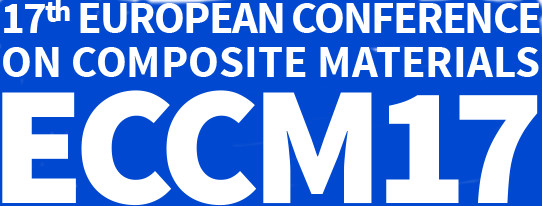

App-Einstellungen:
AUTOMATED DESIGN APPROACH AND POTENTIAL ASSESSMENT OF COMPOSITE STRUCTURES: FAST ANALYTICAL ENGINEERING TOOL FOR MULTIPLE LOAD CASES
Dennis Zink (University of Stuttgart) Christoph Awe (University of Stuttgart) Peter Middendorf (University of Stuttgart)
An alternative analytical evaluation of preferable fiber orientations is presented in this paper. The algorithm computes best fit material orientations based on principal stresses from multiple load cases and evaluates potential for FRP designs.
DIGITPRO – VALIDATING THE LINK BETWEEN BRAIDING SIMULATION, INFILTRATION AND MECHANICAL TESTING
Jörg Dittmann (University of Stuttgart) Daniel Michaelis (University of Stuttgart) Patrick Böhler (University of Stuttgart) Peter Middendorf (University of Stuttgart)
A braided digital prototype is presented. The main goal is to connect the various input and output files of different software tools, to establish a user-friendly readability via a HDF5 file format as well as reducing the product design cycle time.
THE INFLUENCE OF FIBRE ANGLE AND RESIN PROPERTIES ON CONSOLIDATION OF CURVED LAMINATES
Kevin Johnson (University of Bath) Samuel Erland (University of Bath) Richard Butler (University of Bath)
A simple theoretical model is compared with experimental tests at different temperatures and pressures. Pressure-induced shear does not significantly prevent consolidation in curved laminates with differing fibre angles and stacking sequences.
INTEGRATED SIMULATION APPROACH FOR STRUCTURAL ANALYSIS OF COMPOSITE COMPONENTS CONSIDERING PROCESS SIMULATION DATA
Natalie Mayer (Technical University of Munich) Jens Prowe (Airbus Group Innovations) Tamas Havar (Airbus Group Innovations) Roland Hinterhölzl (Technical University of Munich / Institute for Carbon Composites) Klaus Drechsler (Technical University of Munich / Institute for Carbon Composites)
The aim in this study is to include virtual manufacturing process data in the structural finite element analysis on a component level. The main challenge here is to provide an as-built, more realistic structural simulation for composite components.
AN UNDULATED SANDWICH PLATE WITH A NEW CORE
Anil Uzal (Bogazici University) Fazil Onder Sonmez (Bogazici University) Nuri Ersoy (Bogazici University) Kenan Cinar (Bogazici University)
A new core design is introduced. Failure behavior is investigated via three-point bending tests. Both the core and the face sheets are made of E-glass-fiber-reinforced epoxy. Acoustic emission method is used to detect the progression of damage.
COLUMN INTERACTION IN TUFTED SANDWICH STRUCTURES UNDER EDGEWISE LOADING
Jamie Hartley (University of Bristol) Gavin Tse (University of Bristol) James Kratz (University of Bristol) Carwyn Ward (University of Bristol) Ivana Partridge (University of Bristol)
An experimental test method is used to characterise the behaviour of tufts within a sandwich structure under edgewise crush loading. Video tracking highlights drifting and stacking of the tufts, as well as secondary failure mechanisms taking place.
DEFORMATION AND FAILURE BEHAVIOR OF PRE-DAMAGED FOAM-CORE SANDWICH STRUCTURES IN A FOUR-POINT BENDING CONFIGURATION
Marianne John (Fraunhofer IMWS) Ralf Schlimper (Fraunhofer IWM) Christian Mudra (Airbus Operations)
This article deals with the investigation of the mechanical behavior of predamaged foam-core sandwich structures. A four-point bending fixture was used to investigate the mechanical behavior of a sandwich structure with low velocity-impact damage.
DEVELOPMENT OF THE LIGHTWEIGHT INSERTS FOR COMPOSITE SANDWICH PANELS WITH PYRAMIDAL TRUSS CORES
Ge Qi (Center for Composite Materials, Harbin Institute of Technology) Li Ma (Harbin Institute of Technology) Jin-Shui Yang (Harbin Institute of Technology) Lin-Zhi Wu (Harbin Institute of Technology)
Several types of inserts are proposed for composite sandwich panels with pyramidal truss cores. Brief analysis are carried on to discuss the feasibility and validity of insert methods.
EXPERIMENTAL AND NUMERICAL ANALYSIS OF NOMEX HONEYCOMB SANDWICH PANEL INSERTS PARALLEL TO THE FACE SHEETS
Ralf Seemann (Technische Universität Hamburg-Harburg) Dieter Krause (Technische Universität Hamburg-Harburg)
Custom made sandwich inserts, which are placed parallel to the face sheets, are investigated under in-plane tensile loading in experimental and numerical studies. A non-linear simulation model capable of predicting the joint strength is derived.
EXPERIMENTAL STUDY OF THE INDENTATION BEHAVIOUR OF TIED FOAM CORE SANDWICH STRUCTURES
Mohamed Adli Dimassi (Faserinstitut Bremen) Oliver Focke (Faserinstitut Bremen) Christian Brauner (Faserinstitut Bremen) Axel S. Herrmann (Faserinstitut Bremen)
The mechanical behaviour of TFC-Sandwich under quasi-static indentation loads was studied with the aim to investigate the effects of the pin material and pin volume fraction on the indentation response and to determine the pin failure modes.
